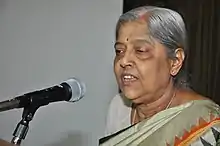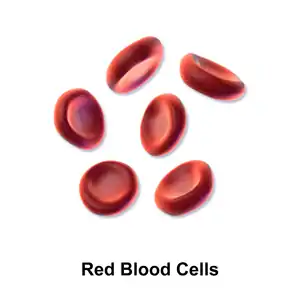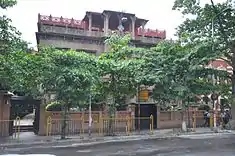Joyoti Basu
Joyoti Basu (born 17 December 1957) is an Indian biochemist, cell biologist and a senior professor at the Bose Institute. Known for her studies on the membrane structure of red blood cells, Basu is an elected fellow of the all the three major Indian science academies namely National Academy of Sciences, India, the Indian Academy of Sciences and the Indian National Science Academy as well as the Indian Society for Chemical Biology. The Department of Biotechnology of the Government of India awarded her the National Bioscience Award for Career Development, one of the highest Indian science awards, for her contributions to biosciences in 2002.[1]
Joyoti Basu | |
|---|---|
| Born | 17 December 1957 West Bengal, India |
| Nationality | Indian |
| Alma mater |
|
| Known for | Studies on interaction of mycobacteria with host macrophages |
| Awards |
|
| Scientific career | |
| Fields | |
| Institutions | |
| Doctoral advisor |
|
Biography

Born on 17 December 1957[2] in the Indian state of West Bengal, Joyoti Basu did her undergraduate studies at the Presidency College, Kolkata and after completing the BSc honors in chemistry, she obtained an MSc from the University of Calcutta.[3] Her doctoral research was at the Bose Institute, Kolkata[4][5] under the guidance of Parul Chakrabarti, which earned her a PhD from Calcutta University. She did her post-doctoral work at the laboratory of Jean-Marie Ghuysen at the University of Liege working on mycobacterial cell division and mycobacterial peptidoglycan-biosynthesizing enzymes. She joined Bose Institute in 1991 as a faculty member at the department of Chemistry[6][7] and retired in June, 2018. Basu resides along Madhab Chatterjee Street in Kolkata.[8]
Controversy
Basu's alleged scientific misconduct has been noted widely and has even been covered in media. She is widely alleged to have duplicated images leading to retraction of two papers, correction of another two, and, many alleged instances of misconduct listed on Pubpeer.[9] Basu has retracted a few of her papers.[10] This includes an article published in The Journal of Immunology.[11][12]
Legacy

Basu's research is focused on the cellular and molecular biology of mycobacteria.[13] During the initial stages of her career, she worked on the membrane structure of red blood cells and her research is reported to have assisted in widening the understanding of apoptosis of nucleated mammalian cells and the physiology of the red cell that lacked a cell nucleus.[3] Her association with her mentor, Parul Chakrabarti, during her doctoral research days, precipitated the studies of the biosynthetic pathways of fatty acids in relation to cell wall building and the functions of penicillin-binding proteins.[14] She is known to be the first scientist to propose that the removal of the aged or oxidatively stressed red blood cells from the circulatory system causes cellular death. Later she moved on to the biological study of Mycobacterium tuberculosis, a pathogenic bacteria causing tuberculosis, with regard to its host-pathogen interaction and her studies revealed the mechanisms of macrophage apoptosis as well as the relationship between host cell signaling and innate immune response. In 2007, the team led by Basu and her college mate from the Presidency College, Manikuntala Kundu, were successful in identifying a protein in Mycobacterium tuberculosis which caused weakening of the immune system of the host.[15] They found that the protein, named Early Secreted Antigen 6, which bound themselves on Toll-like receptor 2 of the host, hindered the production of cytokines, a type of protein which helped the immune system to fight the tuberculosis bacteria. The discovery also has reported importance in the therapeutics of diseases like rheumatoid arthritis.[15] The achievement was later published as an article, Direct extracellular interaction between the early secreted antigen ESAT-6 of Mycobacterium tuberculosis and TLR2 inhibits TLR signaling in macrophages in Nature Immunology journal in 2007.[16] Her studies have been documented by way of a number of articles[17][note 1] and ResearchGate, an online repository of scientific articles has listed 77 of them.[18] Besides, she has mentored several research scholars in their doctoral studies.[19]
Basu is a member of the executive committee of the Indian Society of Cell Biology[20] and is a former Treasurer of the Society.[21][22] She is credited with contributing to the establishment of a program on Systems Biology at the Bose Institute. She is also a former associate editor of the Journal of Immunology and is an Academic Editor of PLoS One.[3]
Awards and honors
Basu received the Young Scientist Medal of the Indian National Science Academy in 1989.[23] The Department of Biotechnology of the Government of India awarded her the National Bioscience Award for Career Development, one of the highest Indian science awards in 2002.[1] The National Academy of Sciences, India elected her as a fellow the same year.[24] She received the elected fellowships of the Indian Academy of Sciences and the Indian National Academy of Sciences in 2006[2] and 2009 respectively.[25] She is a recipient of the J.C. Bose National Fellowship in 2017.
Selected bibliography
- Kumawat, Kuldeep; Pathak, Sushil Kumar; Spetz, Anna-Lena; Kundu, Manikuntala; Basu, Joyoti (23 April 2010). "Exogenous Nef Is an Inhibitor of Mycobacterium tuberculosis-induced Tumor Necrosis Factor-α Production and Macrophage Apoptosis". Journal of Biological Chemistry. 285 (17): 12629–12637. doi:10.1074/jbc.m109.073320. ISSN 0021-9258. PMC 4705387. PMID 20068037.
- Sureka, Kamakshi; Sanyal, Sourav; Basu, Joyoti; Kundu, Manikuntala (1 December 2009). "Polyphosphate kinase 2: a modulator of nucleoside diphosphate kinase activity in mycobacteria". Molecular Microbiology. 74 (5): 1187–1197. doi:10.1111/j.1365-2958.2009.06925.x. ISSN 1365-2958. PMID 19843229. S2CID 32163173.
- Basu, Sanchita; Pathak, Shresh; Pathak, Sushil Kumar; Bhattacharyya, Asima; Banerjee, Anirban; Kundu, Manikuntala; Basu, Joyoti (1 December 2007). "Mycobacterium avium-induced matrix metalloproteinase-9 expression occurs in a cyclooxygenase-2-dependent manner and involves phosphorylation- and acetylation-dependent chromatin modification". Cellular Microbiology. 9 (12): 2804–2816. doi:10.1111/j.1462-5822.2007.00997.x. ISSN 1462-5822. PMID 17590163. S2CID 20264521.
See also
Notes
- Please see Selected bibliography section
References
- "Awardees of National Bioscience Awards for Career Development" (PDF). Department of Biotechnology. 2016. Retrieved 20 November 2017.
- "Fellow profile". Indian Academy of Sciences. 6 December 2017. Retrieved 6 December 2017.
- "Indian fellow - Joyoti Basu". Indian National Science Academy. 6 December 2017. Retrieved 6 December 2017.
- ORCID (9 December 2017). "Joyoti Basu (0000-0002-0497-9581) - ORCID". orcid.org. Retrieved 9 December 2017.
- "LIST of Alumni of BOSE INSTITUTE" (PDF). Bose Institute. 9 December 2017. Retrieved 9 December 2017.
- "Joyoti Basu on Loop". Loop. 9 December 2017. Retrieved 9 December 2017.
- "Joyoti Basu -Bose Institute - Academia.edu". boseinst.academia.edu. 9 December 2017. Retrieved 9 December 2017.
- "NASI fellows". National Academy of Sciences, India. 12 November 2017. Retrieved 12 November 2017.
- "Image duplication: Group at Bose Institute has two papers retracted, two corrected, and many listed on Pubpeer". 9 August 2018.
- "Author objects to retraction for not "faithfully represented" immunology figures". Retraction Watch. 2 October 2015. Retrieved 2 May 2018.
- Basu, Joyoti; Kundu, Manikuntala (15 August 2015). "Retraction: TLR4-Dependent NF-κB Activation and Mitogen- and Stress-Activated Protein Kinase 1-Triggered Phosphorylation Events Are Central to Helicobacter pylori Peptidyl Prolyl cis-, trans-Isomerase (HP0175)-Mediated Induction of IL-6 Release from Macrophages". Retrieved 2 May 2018. Cite journal requires
|journal=(help) - Basu, Joyoti; Kundu, Manikuntala (15 August 2015). "Retraction: TLR4-Dependent NF-κB Activation and Mitogen- and Stress-Activated Protein Kinase 1-Triggered Phosphorylation Events Are Central to Helicobacter pylori Peptidyl Prolyl cis-, trans-Isomerase (HP0175)-Mediated Induction of IL-6 Release from Macrophages". The Journal of Immunology. 195 (4): 1902. doi:10.4049/jimmunol.1501299. PMID 26473200.
- "Bose Institute - Joyoti Basu". www.jcbose.ac.in. 9 December 2017. Retrieved 9 December 2017.
- D. P. Burma; Maharani Chakravorty (2011). From Physiology and Chemistry to Biochemistry. Pearson Education India. pp. 247–. ISBN 978-81-317-3220-5.
- "Hope for a new TB cure, Kolkata scientists identify 'villain' protein". archive.indianexpress.com. 9 May 2007. Retrieved 9 December 2017.
- Pathak, Sushil Kumar; Basu, Sanchita; Basu, Kunal Kumar; Banerjee, Anirban; Pathak, Shresh; Bhattacharyya, Asima; Kaisho, Tsuneyasu; Kundu, Manikuntala; Basu, Joyoti (June 2007). "Direct extracellular interaction between the early secreted antigen ESAT-6 of Mycobacterium tuberculosis and TLR2 inhibits TLR signaling in macrophages". Nature Immunology. 8 (6): 610–618. doi:10.1038/ni1468. ISSN 1529-2916. PMID 17486091. S2CID 22486299.
- "Browse by Fellow". Indian Academy of Sciences. 6 December 2017. Retrieved 6 December 2017.
- "On ResearchGate". 23 November 2017. Retrieved 23 November 2017.
- "Junior Research Fellow" (PDF). Indian Institute of Science. 2006. Retrieved 9 December 2017.
- "EXECUTIVE COMMITTEE MEMBERS OF THE SOCIETY". www.iscb.org.in. 9 December 2017. Retrieved 9 December 2017.
- "EXECUTIVE COMMITTEE MEMBERS OF THE SOCIETY 2003-05". www.iscb.org.in. Retrieved 9 December 2017.
- "EXECUTIVE COMMITTEE MEMBERS OF THE SOCIETY 2005-07". www.iscb.org.in. Retrieved 9 December 2017.
- "INSA Young Scientists Medal". Indian National Science Academy. 12 November 2017. Retrieved 12 November 2017.
- "NASI Year Book 2015" (PDF). National Academy of Sciences, India. 24 November 2017. Retrieved 24 November 2017.
- "INSA Year Book 2016" (PDF). Indian National Science Academy. 9 December 2017. Archived from the original (PDF) on 4 November 2016. Retrieved 9 December 2017.

